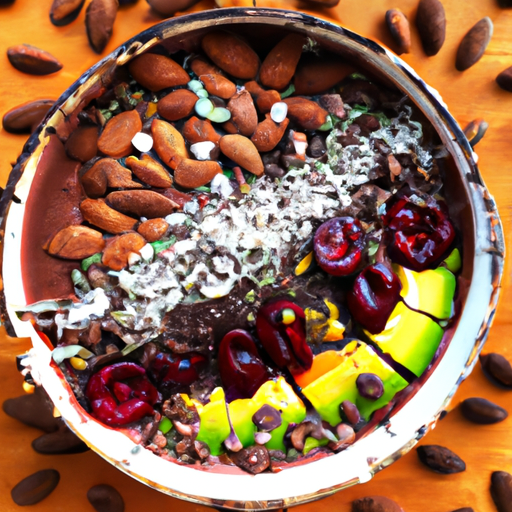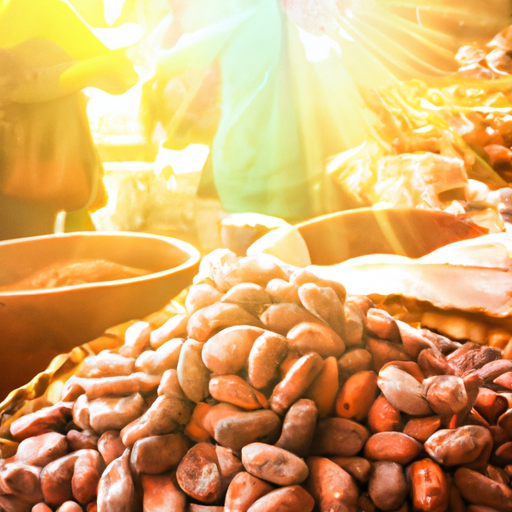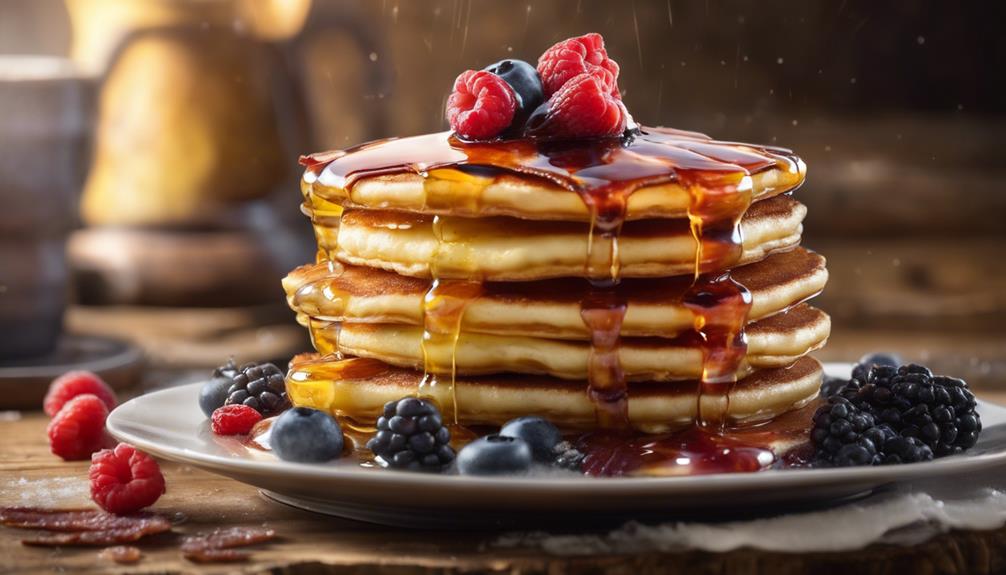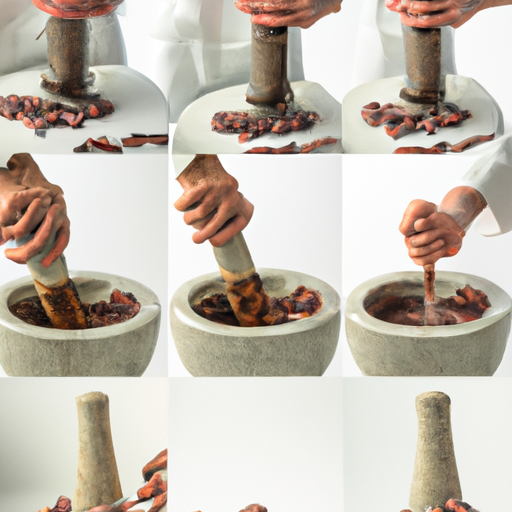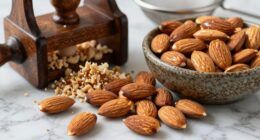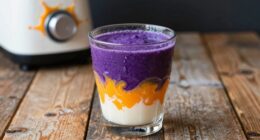I’ve always loved chocolate, but recently I found something even better – raw cacao. And let me tell you, the health benefits are amazing!
Raw cacao is not only delicious, but it’s also packed with nutrients that can boost your overall well-being.
From improving cardiovascular health to enhancing cognitive function, raw cacao has a lot to offer.
Plus, it has mood-boosting properties that can put a smile on your face even on the gloomiest of days.
What’s more, raw cacao has anti-inflammatory effects, supports weight management, and even promotes healthy skin and digestion.
Incorporating raw cacao into your diet is easier than you might think, and the benefits are well worth it.
So if you’re looking for a guilt-free indulgence that can actually improve your health, look no further than raw cacao.
Trust me, your taste buds and your body will thank you.
Key Takeaways
- Boosts metabolism and aids in weight loss
- Enhances natural radiance and promotes a glowing complexion
- Supports digestion by promoting regular bowel movements
- Satisfies the sweet tooth while enjoying health benefits when incorporated into desserts.
Nutritional Profile of Raw Cacao
Raw cacao has a nutritional profile that is bursting with nutrients, making it a deliciously healthy addition to your diet. It is a culinary delight that offers numerous health benefits.
Firstly, raw cacao is rich in antioxidants, which help protect the body against damage from harmful free radicals.
It also contains essential minerals such as iron, magnesium, and calcium, which are crucial for maintaining optimal health.
Additionally, raw cacao is a great source of fiber and protein, which can aid in digestion and promote satiety.
However, it is important to note that raw cacao does have potential side effects, such as allergic reactions and increased heart rate due to its caffeine content.
Despite these potential side effects, the cardiovascular health benefits of raw cacao are remarkable.
Cardiovascular Health Benefits
Indulging in dark chocolate made from raw cacao can be a delicious way to improve your cardiovascular health. Studies show that it can lower the risk of heart disease by up to 37%. Raw cacao is rich in flavonoids, powerful antioxidants that can help reduce inflammation and improve blood flow. These antioxidants also have the potential to lower blood pressure and improve cholesterol levels, both of which are important factors in reducing cardiovascular risk.
Additionally, the high magnesium content in raw cacao can help relax blood vessels and improve overall heart health. Incorporating raw cacao into your diet as part of a balanced lifestyle may contribute to heart disease prevention.
Moving on to the next topic, raw cacao also has mood-boosting properties that are worth exploring.
Mood-Boosting Properties
Feasting on a piece of dark chocolate made from raw cacao can transport you to a state of pure bliss. Its mood-boosting properties are known to uplift your spirits and enhance your overall sense of well-being. Raw cacao contains compounds that act as natural antidepressants, promoting the release of feel-good chemicals like serotonin and dopamine in the brain. These chemicals are responsible for regulating mood and promoting a sense of happiness and relaxation.
Studies have shown that consuming raw cacao can reduce symptoms of anxiety and depression, improving mood and reducing stress levels. Additionally, raw cacao contains flavonoids, which have been found to have positive effects on mental health. These mood-enhancing properties of raw cacao make it a delicious and guilt-free way to improve your emotional well-being.
Transitioning into the next section, let’s explore how raw cacao can also boost cognitive function.
Cognitive Function Improvement
Raw cacao has been shown to have cognitive function improvement properties. It offers benefits such as enhanced focus and concentration. Studies have indicated that consuming raw cacao can also boost memory and learning abilities.
Furthermore, the powerful antioxidants found in raw cacao can help protect brain health and reduce the risk of age-related cognitive decline.
Enhance Focus and Concentration
Boost your mental clarity and sharpen your focus by incorporating the divine power of raw cacao into your daily routine. Raw cacao contains natural compounds that can improve productivity and increase mental clarity.
One of these compounds is caffeine, which stimulates the central nervous system and enhances alertness and concentration.
Additionally, raw cacao is rich in flavonoids, which have been shown to improve blood flow to the brain and support cognitive function.
By consuming raw cacao regularly, you can experience a boost in focus and concentration, allowing you to stay on task and be more productive throughout the day.
In the next section, we will explore how raw cacao can also help boost memory and learning abilities.
Boost Memory and Learning
As I mentioned earlier, raw cacao is not only great for enhancing focus and concentration, but it also has the potential to boost memory and learning. The powerful compounds found in raw cacao, such as flavonoids and antioxidants, have been shown to have positive effects on brain health.
When consumed regularly, raw cacao can help improve cognitive performance and enhance brainpower. Here are four ways in which raw cacao can support memory and learning:
- Enhances blood flow to the brain, aiding in memory retention.
- Boosts the production of neurotransmitters like dopamine and serotonin, which are crucial for learning and memory.
- Reduces inflammation in the brain, preventing cognitive decline.
- Increases the formation of new neurons, improving overall brain function.
By incorporating raw cacao into your diet, you can protect your brain health and support optimal cognitive function.
Now, let’s move on to the next section about how raw cacao can protect brain health.
Protect Brain Health
Incorporating raw cacao into your diet can safeguard your brain and ensure its optimal functioning, allowing you to cherish and preserve your precious memories. Raw cacao contains powerful antioxidants that have protective effects on the brain. These antioxidants help combat free radicals, which can cause damage to brain cells and contribute to cognitive decline. Additionally, raw cacao contains flavonoids that have been shown to enhance cognitive function and improve memory. Studies have also found that the flavonoids in raw cacao may have positive effects on mood and reduce the risk of neurodegenerative diseases like Alzheimer’s and Parkinson’s. By consuming raw cacao, you can support brain health and experience cognitive enhancement. Transitioning to the next section, raw cacao’s anti-inflammatory effects can further contribute to overall well-being.
Anti-Inflammatory Effects
Indulge in the bittersweet pleasure of raw cacao and let its anti-inflammatory properties soothe the fiery storms within your body. Incorporating raw cacao into your diet can provide natural pain relief and support an anti-inflammatory lifestyle. Here are three ways raw cacao can help combat inflammation:
-
Reduced inflammation markers: Raw cacao is packed with flavonoids, which have been shown to lower markers of inflammation in the body. By reducing inflammation, raw cacao can potentially alleviate symptoms of various inflammatory conditions.
-
Antioxidant power: The high levels of antioxidants in raw cacao help neutralize free radicals, which contribute to inflammation. By fighting oxidative stress, raw cacao can help reduce inflammation and promote overall health.
-
Improved cardiovascular health: Chronic inflammation is linked to heart disease. Raw cacao’s anti-inflammatory properties can support heart health by reducing inflammation in blood vessels and improving blood flow.
Transitioning into the next section about weight management support, raw cacao’s anti-inflammatory effects can also play a role in maintaining a healthy weight.
Weight Management Support
Get ready to discover how this delicious superfood can support your weight management journey and help you achieve your goals. Raw cacao has been shown to have potential benefits for weight loss and appetite control. The natural compounds found in cacao, such as flavonoids and polyphenols, have been linked to increased feelings of fullness and reduced cravings. Additionally, cacao contains a compound called theobromine, which has been found to stimulate thermogenesis, the process by which the body burns calories to produce heat. This can potentially boost metabolism and aid in weight loss.
To further illustrate the potential weight management benefits of raw cacao, take a look at the table below:
| Benefit | Description | Emotional Response |
|---|---|---|
| Increased feelings of fullness | Helps you feel satisfied and less likely to overeat | Contentment and control |
| Reduced cravings | Suppresses the desire for unhealthy snacks | Empowerment and discipline |
| Boosted metabolism | Burns more calories, aiding in weight loss | Motivation and progress |
| Appetite control | Regulates hunger and prevents overeating | Balance and mindfulness |
As you can see, raw cacao offers a variety of benefits that can contribute to your weight management journey. Now, let’s delve into its skin health benefits.
Skin Health Benefits
Pamper your skin with the nourishing power of this delightful superfood. It works wonders in enhancing your natural radiance and leaving you with a glowing complexion.
Raw cacao, with its abundant antioxidants and essential minerals, offers a range of skin health benefits. It helps protect the skin against free radicals, reducing the signs of aging and promoting a youthful appearance.
Additionally, raw cacao contains flavanols that improve blood flow to the skin, resulting in a healthy, vibrant glow. Its anti-inflammatory properties can also soothe irritated skin and reduce redness.
As one of nature’s natural remedies, raw cacao can assist in aging gracefully by nourishing and revitalizing the skin.
Transitioning into the subsequent section about digestive health benefits, let’s explore how raw cacao can benefit our overall well-being.
Digestive Health Benefits
Boost your digestive system with the powerful properties found in this delightful superfood. Raw cacao is not only a treat for your taste buds, but it also provides numerous benefits for your gut health.
The high fiber content in raw cacao helps to support digestion by promoting regular bowel movements and preventing constipation. Additionally, raw cacao contains natural enzymes that aid in breaking down food and improving nutrient absorption.
The antioxidants present in raw cacao can also reduce inflammation in the gut and promote a healthy digestive system.
To incorporate raw cacao into your diet and reap these digestive health benefits, you can add it to smoothies, sprinkle it on yogurt or oatmeal, or even enjoy a piece of dark chocolate.
Transitioning into the next section, let’s explore how to incorporate this superfood into your daily routine.
Incorporating Raw Cacao into Your Diet
To enhance your culinary experience, consider incorporating raw cacao into your daily diet in various creative ways.
Raw cacao can be used in a multitude of recipes to add a rich and decadent flavor to your favorite desserts. From homemade chocolate bars to raw cacao smoothies, the possibilities are endless.
One popular recipe is raw cacao energy balls. These delicious and nutritious treats combine raw cacao powder, dates, nuts, and coconut oil.
Another option is to add raw cacao powder to your morning smoothie or oatmeal. This will give you a boost of antioxidants and a chocolatey taste.
Additionally, you can sprinkle raw cacao nibs on top of your yogurt or incorporate them into your homemade granola. This will add crunch and flavor to your breakfast.
By incorporating raw cacao into your desserts, you can enjoy its health benefits while satisfying your sweet tooth.
Frequently Asked Questions
Can raw cacao help improve symptoms of depression or anxiety?
Raw cacao has been shown to have mood-enhancing properties, making it potentially helpful for managing symptoms of depression or anxiety. It can reduce stress and promote feelings of relaxation and well-being.
Does raw cacao have any impact on blood sugar levels?
Raw cacao can have a positive impact on blood sugar levels. Studies suggest that it may help regulate blood sugar and improve insulin sensitivity, which can be beneficial for weight loss and heart health.
Is it safe to consume raw cacao during pregnancy or while breastfeeding?
While raw cacao offers numerous health benefits, it’s important to exercise caution during pregnancy or breastfeeding. The effects of raw cacao on fertility and hormonal balance during these stages are not yet fully understood.
Can raw cacao be beneficial for individuals with diabetes?
Raw cacao can potentially benefit individuals with diabetes by improving insulin response and glycemic control. Research suggests that the antioxidants and flavanols in raw cacao may help regulate blood sugar levels, but further studies are needed for conclusive evidence.
Are there any potential side effects or risks associated with consuming raw cacao?
Consuming raw cacao may pose potential risks for individuals with allergies. Additionally, it can interact with certain medications, so it’s important to consult with a healthcare professional before incorporating it into your diet.
– Are There Actual Health Benefits of Raw Cacao or Does It Actually Cause Cancer?
Raw cacao does not pose a cancer risk, and in fact, it offers potential health benefits. Research suggests that raw cacao is rich in antioxidants and may help lower blood pressure, improve heart health, and reduce inflammation. Consuming raw cacao in moderation can be part of a healthy diet.
Conclusion
In conclusion, the health benefits of raw cacao are truly remarkable. Not only does it provide a rich and delicious taste, but it also offers a plethora of nutritional advantages.
Raw cacao promotes cardiovascular health by improving blood flow and reducing the risk of heart disease. It contains flavonoids that help lower blood pressure and reduce inflammation, leading to a healthier heart.
Additionally, raw cacao can improve cognitive function. It contains compounds that stimulate the production of endorphins and serotonin, which can enhance mood and mental well-being. The antioxidants in cacao also protect brain cells from oxidative stress, potentially reducing the risk of neurodegenerative diseases.
Raw cacao can also support weight management. It is low in calories and high in fiber, which helps promote feelings of fullness and reduce cravings. The magnesium in cacao can also regulate blood sugar levels and improve insulin sensitivity, aiding in weight control.
Furthermore, raw cacao is beneficial for skin health. Its high antioxidant content helps protect the skin from damage caused by free radicals, reducing signs of aging and promoting a youthful appearance. Cacao also contains nutrients like zinc and sulfur, which can improve skin elasticity and reduce inflammation.
So why wait? Start incorporating this superfood into your diet today and reap the benefits of its amazing properties. Your body and mind will thank you!

